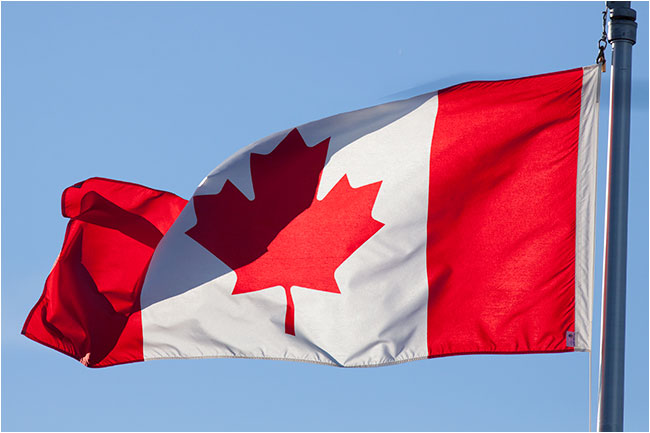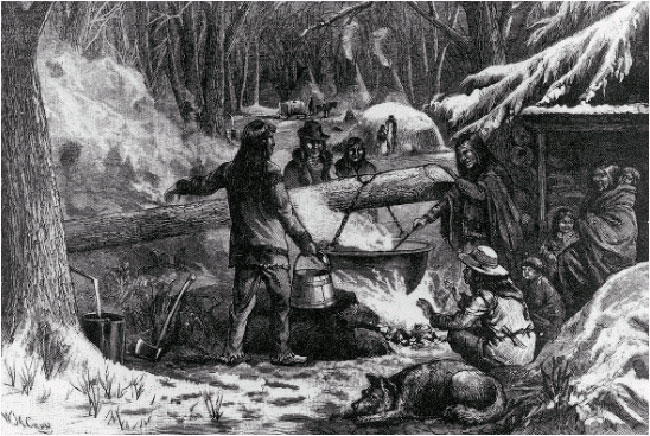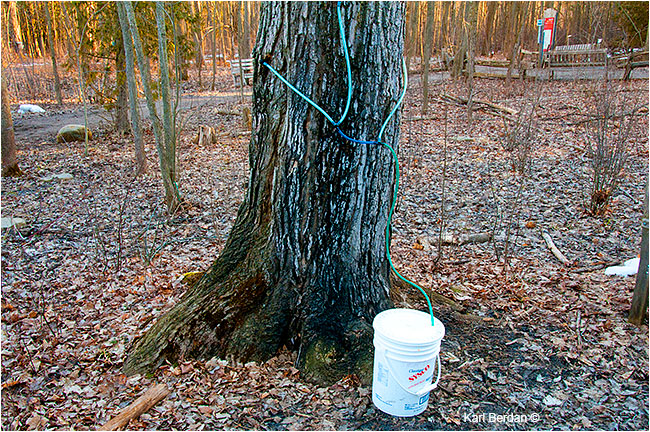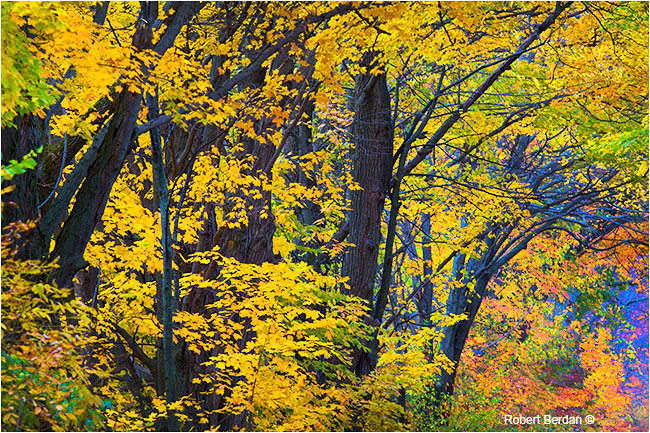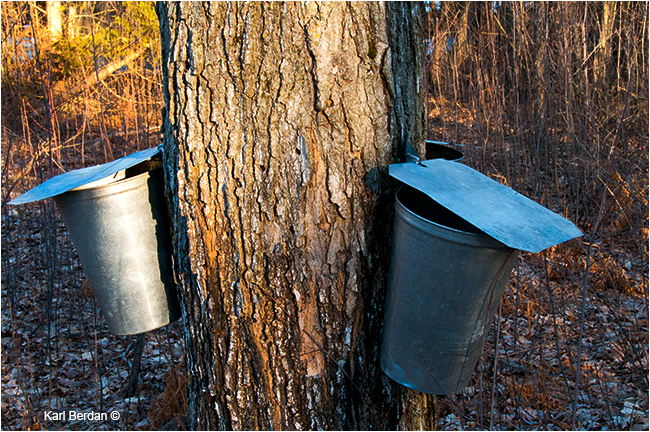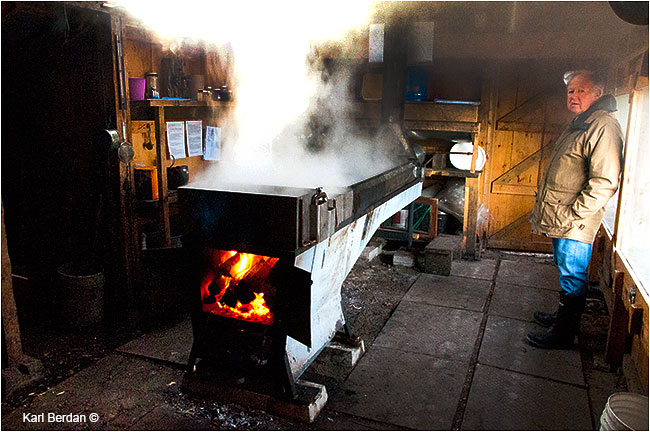
Canadian Maple Syrup and How it's Collected
Photographs and article by Karl and Robert Berdan
April 28, 2013

Leaf from the Sugar Maple (Acer saccharum) tree in Autumn - the leaves can turn yellow, orange and even bright red.
Red maple leaves in autumn are a favourite subject for many nature photographers.
The maple leaf is proudly displayed on the Canadian Flag
Nothing tastes more Canadian than the sweet taste of Maple syrup on French toast or pancakes. Every spring in eastern Canada maple syrup producers tap maple trees and boil the sap into a sweet brown coloured syrup. No one knows exactly when this process first started, but it is believed that first nations people living around the great lakes and St. Lawrence river were the first to make a sweet drink from maple trees and they showed early settlers how to collect the sap. The sap was called “sinzibuckwud” by the Algonquin Indians literally meaning “drawn from wood” (source A history of Maple Syrup).
First Nations boiling sap to create Maple syrup (diagram source Wikipedia)
It’s thought the Indians concentrated the sap by boiling the syrup in clay pots and also by removing the top layers of ice after freezing. They used it as a sweet drink. The first white settlers used wooden buckets to collect the sap and boiled the sap in copper kettles. The custom of collecting sap each spring became an integral part of colony life in the 17th and 18th century.
Tin buckets used to collect maple sap near Midland, Ontario.
A large maple tree has several taps leading to a plastic bucket.
Today maple syrup production is primarily a north American product with most of it being produced in Canada, primarily Quebec and Ontario and a small amount in the north eastern US. There is fear that the production in the US may be lost in the future due to global warming.
Sugar maples line the road near Midland Point, Ontario.
Sugar Maple seed photo by Steve Hurst @ USDA-NRCS PLANTS Database - Wikipedia
Maple syrup is made primarily from the sap of the sugar maple (Acer saccharum) and the red maple (Acer rubrum). These trees provide the sweetest sap with about 2% sugar content. The sap is collected into buckets and then boiled until the sugar content reaches 66% or 66 Brix. It takes about 40 litres of sap to make one litre of maple syrup. A new process using reverse osmosis can reduce up to 80% of the water saving cost and speeding up the boiling. The sugar content is measured using a hydrometer. After boiling the syrup it is filtered to remove any gritty material. The last step is to grade the maple syrup which is also sterilized by warming it to 180° F before packing. Classification of maple syrup is based on its colour and translucence. To make the best syrup, the sap should be boiled the same day its collected.In order for the maple trees to produce enough sap they need to be about 40 years old. The amount of sap produced by a tree also depends on its size. A tree with 17 inch diameter trunk should only by tapped once, a 18-24 inch diameter tree – 2 taps, and a 25 inch or more diameter tree can have 3 or more taps. The holes should only be drilled when the temperature is above freezing, using a 7/16 inch drill at a slight upward angle approximately 2 to 2.5 inches deep. Once a hole is drilled install a tap by pushing it up into the hole and secure it lightly with a hammer. Supplies are available at some hardware stores or on the internet - see links below.
Tree Physiology - How Do Trees Make Sap?
In late summer and fall, maples stop growing and begin to store their excess starch throughout the sapwood in ray cells. The excess starch remains as long as the temperature in the wood is colder than about 40° F . In spring time when the temperature starts to rise above 40 °F during the day, enzymes in the wood convert the starch to sugar, mainly sucrose which passes into the tree sap. Once temperatures exceed 45 °F the enzymes stop functioning and sugar is no longer produced. Depending on the latitude this process usually starts in March and April, but it can vary drastically from year to year as does the production of Maple syrup.
Sap drips into a bucket which is then collected and concentrated.
Early settlers would boil the sap over an open fire.
Economic Worth of Maple Syrup
Canada produces about 85% of the maple syrup with Quebec being the biggest producer creating about 96 million pounds in 2012 worth more than $270 million dollars. About 2\3 of the maple syrup produced is exported to the US with the rest being exported to Japan, Germany, France and the UK. Grade A syrup sells for about $32\gallon or $1800\barrel - that is about 13X the price of crude oil. Maple syrup is the true liquid gold.
Sugar Shack, also known as a sap house or sugar cabin is a semi-commercial establishment where sap is collected and boiled into syrup.
Inside of the sugar shack, sap is concentrated into maple syrup - it takes about 40 gallons of sap to make 1 gallon of syrup. A single tree can produce about 15 gallons of sap on a good year.
When Canada's Prime Minister, Stephen Harper travels abroad, his gift for foreign leaders often includes a selection of Canada’s finest maple syrup.
The majority of photographs for this article were taken by Karl Berdan who attended the Sweetwater Harvest Festival at the Wye Marsh Center in Midland Ontario this past March. Karl used a Nikon D300 camera and a Nikon 18-200 mm zoom lens to document the maple syrup festival. Robert attended the Elmvale Maple Syrup festival when he was a teenager and remembers pouring maple syrup on snow and eating the natural treat. For a list of maple syrup festivals in Eastern Canada please see the links below. Robert had French toast and fresh maple syrup for breakfast from the bottle above to provide fuel for writing this article. If you have never tasted maple syrup you don't know what you are missing :-).
Links and Resources
- How to Make Maple Syrup at Maple Syrup World
- Maple Syrup Grading
- Tap my Trees - web site about home based maple sugaring
- Maple Sugar supplies to do it yourself
- How to tap maple tress and make Maple syrup - PDF
- Buy Maple syrup online at Jakeman's
- Atkinson Maple Syrup Supplier near Barrie Ontario
- History of Maple Syrup
- Maple Syrup Wikipedia
- History of Maple Syrup in Quebec
- Maple Sugar Industry - The Canadian Encylopedia
- Maple Syrup Recipes
- Maple Syrup supplies and Home Hardware
- Diagram of the Maple tree leaves that can be used for their identification
- Canadian Maple Syrup Festivals
- How to make Maple Syrup
- The Maple Syrup Book at Amazon.ca
- Will Maple Syrup Disappear due to Global Warming?
- Maple Syrup Heist Bloomberg Businessweek.
- Quebec Maple Syrup Federation of Producers
- Ontario Maple Syrup Producers Associaion OMSPA - also lists maple syrup festivals
- Elmvale Maple Syrup Festival
- Wye Marsh in Midland Ontario - Sweeetwater Maple Syrup Festival
- Artificial maple syrup - which is the best? (None of them!!!!)
- How to make Artificial Maple syrup at home - but why when you can get the real stuff?
[ Top ] |

